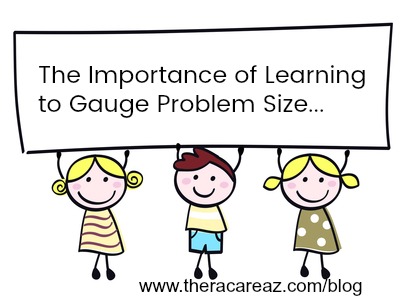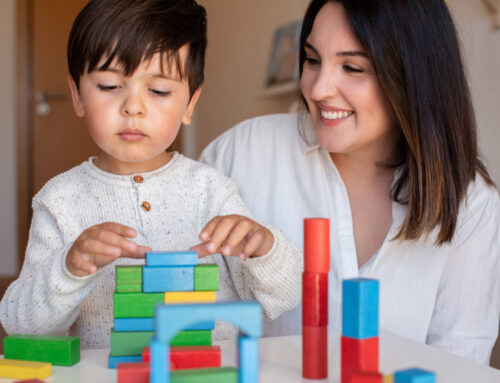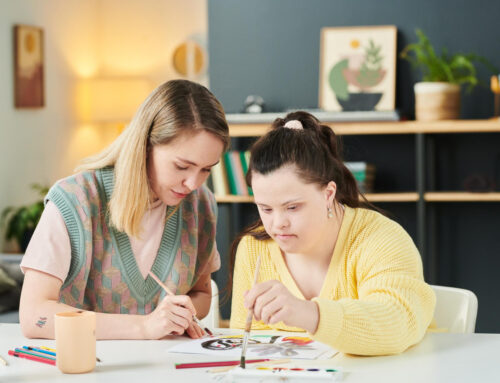
Teaching problem solving in speech language pathology can encompass many skills including learning to identify when there is a problem, and helping providing solutions to problems. Being able to do both of these enables a person to be safer and more independent within various environments (home, community and school). One aspect of problem solving skills that I like to focus on when working on problem solving is learning to gauge the size of problems. While this might not seem as imperative as being able to identify and solve when problems are happening, this skill addresses two important areas: safety and reaction/pragmatics.
When teaching this skill, I like to provide criteria for each problem size. In simplest terms, a small problem is easy to solve, only effects ourself or one other person, and can be solved quickly. Examples of small problems could include the Ipad is not charged, don’t like the food choices of a meal, unable to do a desired activity, etc. A medium problem may effect a small group of people, and the problem is of longer duration. More resources or time may be needed to solve this problem. From a pragmatic perspective, a medium problem may involve hurt feelings. Examples of a medium problem could be a dropped birthday cake, you don’t get picked for a team, or your friends aren’t talking to you. A large problem effects a large number of people and/or may take a lot of resources or time to solve. Any problem where danger may be a possibility is viewed as a large problem. Examples of a large problem could include you cut your finger and don’t know if it needs stitches, you get separated from your parents on vacation, or a stranger is trying to talk to you . (You can also address the problem size of catastrophic problems (house fire, natural disaster, etc). However, all of these would have a parent or trusted adult involved automatically.
So, why is being able to determine the size of a problem such an important skill? I find there are two benefits to working on this skill. One, being able to correctly gauge the size of a problem as small, medium, or big helps provide criteria for if help from a parent or trusted adult is needed. Knowing when help from an adult is needed improves overall personal safety, whereas knowing when a problem can be safely handled on one’s own improves independence and confidence.
Secondly, if we are taught to gauge the size of a problem appropriately, then we can work on the skill of matching our reaction to the problem size. If someone has a big response to a small problem, this has pragmatic implications. For example, if a child is told they have to share a toy and has a meltdown, they are having a big reaction to a small problem. By learning this is in fact a small problem, we can then help the child learn to have an appropriate sized reaction (play something else while you wait, know they can have a turn later, it is good to share with our friends). Likewise, the reverse can also happen. If a large problem is happening, for example, flunking classes, but the child is having a small reaction (indifference) we can lead them to understand this is a large problem and therefore a larger reaction is necessary (study more, get grades up, be able to graduate).
Gauging problem size correctly is a good skill for all age groups, child to adult. While an often overlooked scope of problem solving, learning to correctly gauge problem size enables those learning this skill to improve their overall safety and independence, and can lead to an improvement of social skills by improving appropriateness of reactions to given problems that can happen in everyday routines and situations.
How to teach gauging problem size:
Decide your criteria for each problem size (I like using this packet when teaching this skill in therapy sessions) and teach the differences between them.
Explain and provide examples of each type of problem size. (The teaching of the skill must come before the question/answering of a skill).
Start with visual examples (flashcards that depict everyday problems, freeze frames of problems depicted in media, etc.) Show the example and ask what size problem it is and why. I like to match my examples to those that could realistically happen within my child’s (or my client’s) daily environments.
Once there is good understanding with visual examples, move to verbally presented ones. (“Your wanted to wear your favorite shirt today, but it is dirty. Is that a small, medium, or big problem?”). Discuss why it is a small problem–Only effects one person, easy to solve (wear a different shirt, you can wear it again as soon as it is laundered).
This goal is easily linked to common problem solving goals by expanding the task. For example, we can ask to identify the problem in a photo, then determine the size of that problem. Once problem size has been determined, we can then prompt for solutions to the given problem.

Katie Sullivan, M.S., SLP-CCC

has been a pediatric Speech Language Pathologist for 23 years, and is a Therapy Supervisor with Theracare. She is the mother to five children, ages 8-18, including twin teenage sons with special needs. You can follow her at the My Sweet Homeschool blog, facebook, twitter, and instagram.





